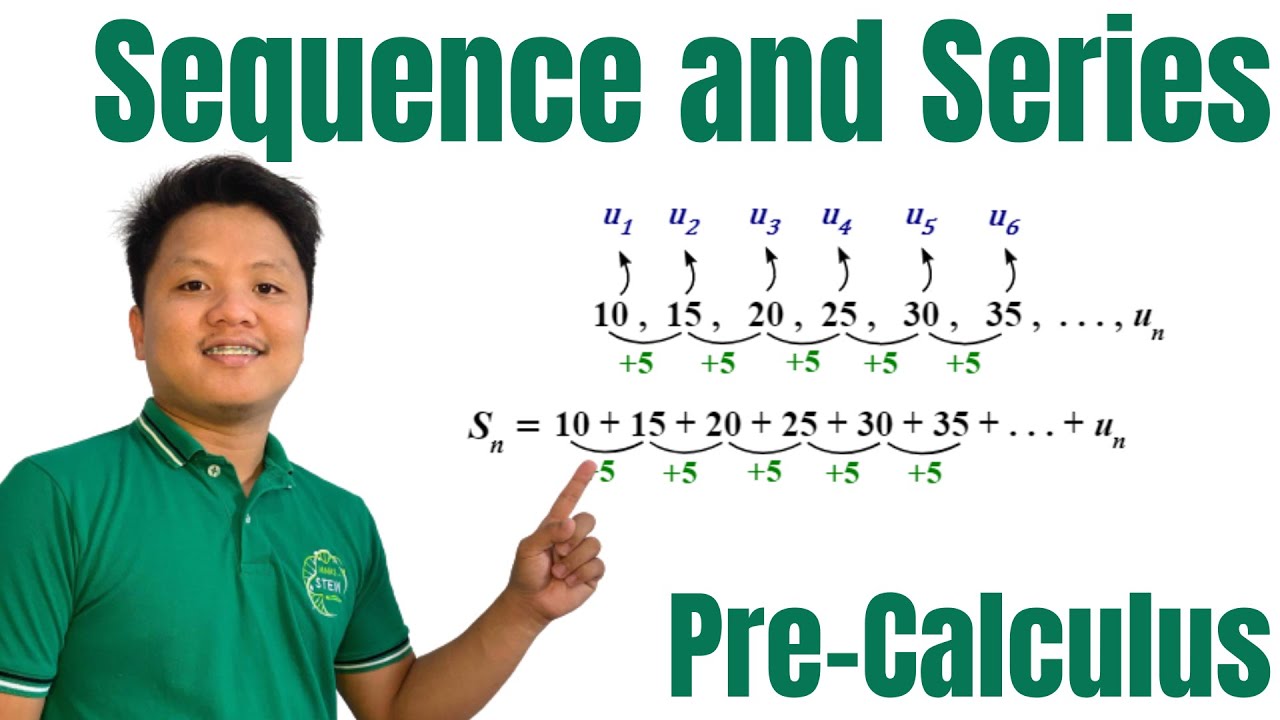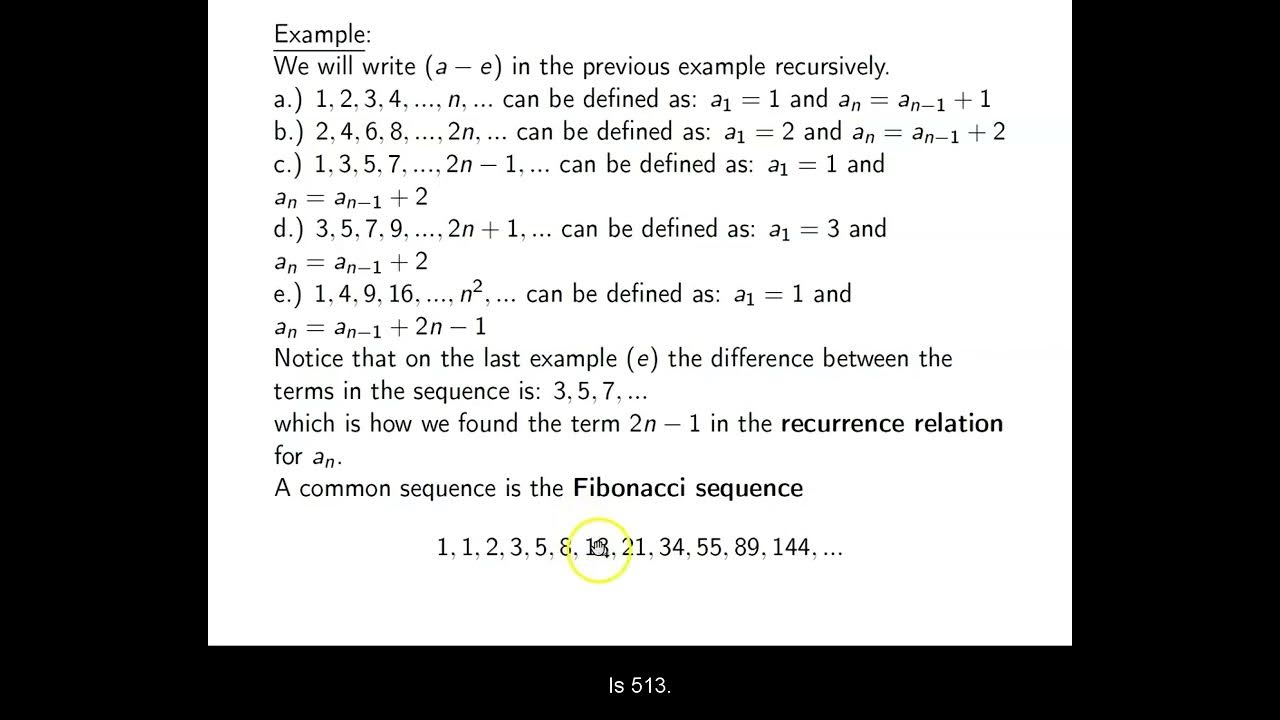Introduction to Sequences (Precalculus - College Algebra 67)
TLDRThe video script delves into the fascinating world of sequences and series, providing a comprehensive guide on how to understand and manipulate these mathematical constructs. It clarifies the distinction between a sequence, which is a list of numbers generated by a formula based on an index, and a series, which involves adding these numbers together. The script offers a step-by-step approach to finding terms within a sequence by substituting the index into the formula. It also touches on the concept of natural numbers in the context of indices and explores patterns within sequences, such as identifying and predicting terms through addition of odd numbers. The process of generalizing sequences to find a formula for any given term is emphasized, showcasing its importance in higher mathematics, including calculus. The script concludes with a teaser for the next video, which will explore series in more depth.
Takeaways
- 📝 A sequence is a list of numbers generated by a formula based on the index of the term.
- 🔢 The index in a sequence is the position of the term and is used to find any specific term within the sequence by substituting it into the formula.
- 🚫 The index (n) in a sequence is typically a natural number, meaning it cannot be a fraction, decimal, or negative.
- 🔁 The pattern in a sequence often involves adding or multiplying by a certain number to progress from one term to the next.
- 🤔 To find a specific term in a sequence, simply substitute the index value into the formula to calculate that term.
- 📈 A series is the sum of the terms in a sequence, which involves more mathematical operations compared to listing a sequence.
- 🤝 The relationship between sequences and series is that a series is created by adding up the terms of a sequence.
- 🧮 Mathematical proof by induction is a method used to prove statements that are true for all natural numbers, often related to sequences and series.
- ➡️ The general term of a sequence is represented as 'a_sub_n', which signifies the nth term of the sequence.
- 🔍 To derive the formula for a sequence from a given list of numbers, identify the pattern and relate it to the index, then generalize it for any term.
- 📉 Sequences can also represent exponential decay or growth, as shown by the example where the terms approach zero as the index increases.
Q & A
What is the main topic of the video?
-The main topic of the video is sequences and series in mathematics, including how to identify and work with them to find specific terms or create a general formula.
What is the difference between a sequence and a series?
-A sequence is a list of numbers generated by a formula based on the index of the term, while a series is the sum of the numbers in a sequence.
How does one find a specific term in a sequence?
-To find a specific term in a sequence, you substitute the index of the term you want to find into the formula that generates the sequence.
What are the restrictions on the index used in a sequence?
-The index used in a sequence is typically a natural number (positive whole numbers starting from one), and cannot be a fraction, decimal, or negative number.
How can one identify the pattern in a sequence?
-One can identify the pattern in a sequence by looking at the differences between consecutive terms or by observing how the formula changes with each term.
What is the purpose of finding the general term of a sequence?
-The purpose of finding the general term of a sequence is to be able to find any term in the sequence without having to list out all the previous terms.
How does the video help in understanding the concept of mathematical induction?
-The video does not directly discuss mathematical induction, but it lays the groundwork for understanding sequences and series, which are foundational concepts used in mathematical induction.
What is the significance of the formula a_n = n^2 + 1 in the script?
-The formula a_n = n^2 + 1 is used as an example to demonstrate how to find specific terms in a sequence by substituting the index n with the desired term number.
How does the video script illustrate the creation of a sequence formula from a given list of numbers?
-The script illustrates this by showing the process of writing down terms, making them all the same form, identifying relationships among the terms, and then relating these to the index n to find the general term formula.
What is the role of 'alternating signs' in sequences?
-Alternating signs in sequences, often represented by (-1)^n or (-1)^(n-1), are used to create a pattern where the sign of the terms alternates between positive and negative as the index n changes.
How does the script demonstrate the concept of 'recursive' formulas in sequences?
-The script demonstrates recursive formulas by explaining that to find a term in the sequence, you can use the value of the previous term and apply a certain operation (like addition) to it, without needing the general formula for the sequence.
What is the importance of recognizing 'unchanging elements' in a sequence when creating a general formula?
-Recognizing 'unchanging elements' helps in identifying the constant parts of the sequence formula, which can then be related to the index n, allowing for the creation of a general formula that can predict any term in the sequence.
Outlines
😀 Introduction to Sequences and Series
The video begins with an introduction to sequences and series, explaining the difference between the two. A sequence is a list of numbers generated by a formula based on the term's index, while a series is the sum of a sequence. The presenter emphasizes the importance of understanding how sequences are created and used, and how to find any term within a sequence by substituting the index into the formula. The video also outlines the plan to discuss specific types of sequences and series, such as arithmetic and geometric progressions, and to include mathematical proofs by induction in subsequent videos.
📚 Sequences as Formula-Based Lists
This paragraph delves deeper into sequences, illustrating how they are lists of numbers generated by a formula that includes an index. The index represents the position of a term in the sequence. The presenter demonstrates how to find specific terms of a sequence by substituting the index into the formula. It is clarified that the index, or n, must be a natural number, meaning it cannot be a fraction, decimal, or negative. The video also shows how to identify patterns within a sequence and how to use these patterns to predict subsequent terms without explicitly listing them all.
🔢 Identifying Patterns in Sequences
The presenter discusses the importance of recognizing patterns in sequences and how to derive a general formula from a given list of numbers. They provide a step-by-step method for students to follow when faced with a sequence: writing down the terms, ensuring they are in the same form, identifying what remains constant and what changes, and then relating the changing elements to the index, n. This process allows for the general term of the sequence to be found, which can be used to determine any term in the sequence without listing all preceding terms.
🔁 Alternating Signs and Sequence Patterns
The paragraph explores sequences with alternating signs, demonstrating how the sign alternates with each term. It explains that this is achieved by raising -1 to the power of the term's index minus one, which results in a positive or negative value depending on whether the exponent is even or odd. The presenter shows how to identify the numerator and denominator patterns and how they relate to the sequence's index. They also emphasize the importance of recognizing and maintaining the sequence's pattern when expressing terms with alternating signs.
🤔 Finding the General Term from a Sequence
The focus of this paragraph is on the process of finding the general term of a sequence from a given list of numbers. The presenter advises writing down the terms, ensuring they are all in the same form, and then identifying the parts of the terms that are changing and those that remain constant. They explain how to relate the changing parts to the sequence's index, n, to derive the general term. The video also touches on the concept of recursive formulas, which are used to define sequences where each term is based on the previous term or terms.
📝 Writing the General Term for a Sequence
The final paragraph of the script provides a detailed example of how to write the general term for a sequence, specifically focusing on sequences that involve alternating signs and multiplication by a constant. The presenter guides the viewer through the process of identifying the constant elements and the elements that change according to the sequence's index. They also discuss how to handle the alternating signs by introducing a factor of -1 raised to an appropriate power. The paragraph concludes with a reminder of the importance of practice in mastering the skill of deriving general terms from sequences.
Mindmap
Keywords
💡Sequence
💡Series
💡Arithmetic Sequence
💡Geometric Sequence
💡Index
💡Mathematical Induction
💡Natural Numbers
💡General Term
💡Recursive Formula
💡Exponential Decay
💡Horizontal Asymptote
Highlights
The video introduces the concept of sequences and series, emphasizing the mathematical importance of these topics.
A sequence is defined as a list of numbers generated by a formula based on the index of the term.
The difference between a sequence and a series is clarified, with a series being the sum of a sequence.
The index of a term in a sequence is explained as the position number of that term in the sequence.
The formula for finding any term in a sequence is demonstrated by substituting the index into the formula.
The video discusses the limitations of the index 'n', noting it must be a natural number and cannot be decimal, zero, or negative.
The pattern within a sequence is explored, showing how to identify and predict subsequent terms based on the sequence's rule.
The general term of a sequence is introduced, which is the formula that can be used to find any term in the sequence.
The concept of mathematical induction is mentioned as a method for proving statements about sequences.
The video provides an example of finding the nth term of a sequence using the formula a_n = n^2 + 1.
Different types of sequences, such as arithmetic and geometric sequences, are mentioned to be discussed in subsequent videos.
The process of finding a formula for a sequence from a given list of numbers is demonstrated step by step.
The importance of recognizing patterns and relating them to the index 'n' is emphasized for creating a general term formula.
The video illustrates how to handle alternating signs in a sequence and incorporate them into the general term formula.
The method for identifying and working with recursive formulas, which rely on previous terms to define subsequent terms, is explained.
The practical application of sequences in higher mathematics, such as calculus, is highlighted to motivate their study.
The video concludes with a teaser for the next topic: series, which involves adding up the terms of a sequence.
Transcripts
Browse More Related Video

Geometric Sequences (Precalculus - College Algebra 71)

Introduction to Series and Summation Notation (Precalculus - College Algebra 68)

Arithmetic Sequences (Precalculus - College Algebra 69)

Sequence and Series | Terms of Sequence and Associated Series | Pre-Calculus

ILLUSTRATING SEQUENCES AND SERIES || PRECALCULUS

Ch. 12.1 Sequences and Summation Notation
5.0 / 5 (0 votes)
Thanks for rating: